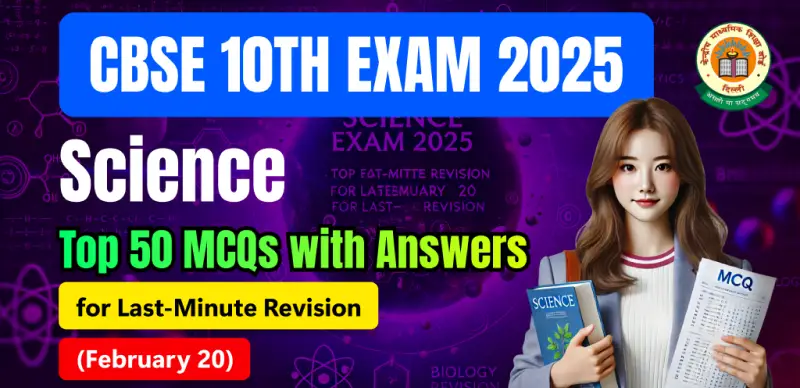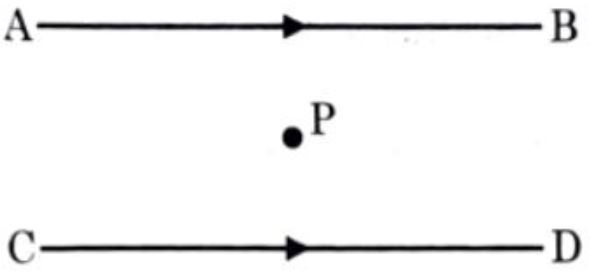CBSE Class 10 Science Exam 2025 : Top 50 MCQs with Answers for Quick Revision (February 20)

SHARING IS CARING
If our Website helped you a little, then kindly spread our voice using Social Networks. Spread our word to your readers, friends, teachers, students & all those close ones who deserve to know what you know now.
CBSE 10th exams are underway and your CBSE 10th Science exam is scheduled on 20th Feb, 2025. You have just a few hours left for CBSE 10th Science exam.
👉 Read Also- CBSE 10th Science Exam 2025 : Important Diagrams for Last-Minute Preparation
We have prepared top 50 MCQs with answers covering all the important topics of CBSE Class 10 Science syllabus.
👉 Read Also- CBSE 10th Science Exam 2025 : VVI Most Important Questions For Last Minute Revision - Download Free PDF
Students are advised to solve these questions before the exam so that they are 100% prepared to solve questions from the actual board paper. These multiple choice questions will help students strengthen their conceptual understanding and boost their confidence before appearing for the exam.
👉 Read Also- CBSE Class 10 Science Exam 2025: Important Competency-Based Questions for Last-Minute Revision
Make sure to solve these MCQs and refer to the solutions to ensure that you are well prepared to score high in CBSE Class 10 Science exam 2025.
CBSE 10th Science 2025: Top 50 MCQs with Solutions
1. What type of reaction is represented by the following equation? 2Mg + O2 → 2MgO
(a) Combination Reaction
(b) Decomposition Reaction
(c) Displacement Reaction
(d) Redox Reaction
Answer: (a) Combination Reaction
2. Which of the following is an example of a double displacement reaction?
(a) NaCl + AgNO3 → AgCl + NaNO3
(b) 2H2 + O2 → 2H2O
(c) Zn + HCl → ZnCl2 + H2
(d) CaCO3 → CaO + CO2
Answer: (a) NaCl + AgNO₃ → AgCl + NaNO₃ (Double Displacement Reaction)
3. What is the pH of pure water?
(a) 5
(b) 7
(c) 9
(d) 11
Answer: (b) 7 (pH of pure water)
4. Which of the following is a strong acid?
(a) Acetic acid
(b) Citric acid
(c) Hydrochloric acid
(d) Carbonic acid
Answer: (c) Hydrochloric acid (Strong acid)
5. Which metal is the best conductor of electricity?
(a) Iron
(b) Copper
(c) Silver
(d) Aluminium
Answer: (c) Silver (Best conductor of electricity)
👉 Read Also- CBSE Class 10 Science 2025: Quick Revision Notes with Tricks, Mnemonics & Solved Examples
👉 Read Also- CBSE Board 10th Science Exam 2025 : Last Day Revision with Most Important Questions with Solution
6. What is the nature of oxides of non-metals?
(a) Basic
(b) Acidic
(c) Neutral
(d) Amphoteric
Answer: (b) Acidic (Nature of oxides of non-metals)
7. The general formula of alkane is:
(a) CnH2n
(b) CnH2n+2
(c) CnH2n-2
(d) CnH2n+1
Answer: (b) CₙH₂ₙ₊₂ (General formula of alkane)
8. The functional group present in aldehyde is:
(a) -OH
(b) -COOH
(c) -CHO
(d) -CO
Answer: (c) -CHO (Functional group of aldehyde)
9. Which part of the plant is responsible for photosynthesis?
(a) Root
(b) Stem
(c) Leaf
(d) Flower
Answer: (c) Leaf (Responsible for photosynthesis)
10. In human digestion, which enzyme breaks down starch?
(a) Pepsin
(b) Trypsin
(c) Amylase
(d) Lipase
Answer: (c) Amylase (Breaks down starch)
👉 Read Also- CBSE Class 10 Science 2025: Chapter-Wise MCQs with Answers, Free PDF Download
👉 Read Also- CBSE Board Class 10 Science Exam 2025 : Chapter-Wise Most Predicted Questions with Answers; Download Free PDF
11. Which hormone regulates blood sugar levels?
(a) Thyroxine
(b) Insulin
(c) Adrenaline
(d) Estrogen
Answer: (b) Insulin (Regulates blood sugar levels)
12. What is the functional unit of the nervous system?
(a) Nephron
(b) Neuron
(c) Alveoli
(d) Axon
Answer: (b) Neuron (Functional unit of the nervous system)
13. What is the mode of reproduction in bacteria?
(a) Budding
(b) Binary fission
(c) Fragmentation
(d) Sporulation
Answer: (b) Binary fission (Mode of reproduction in bacteria)
14. Which of the following is an example of asexual reproduction?
(a) Fertilization
(b) Pollination
(c) Budding in yeast
(d) Zygote formation
Answer: (c) Budding in yeast (Example of asexual reproduction)
👉 Read Also- CBSE Class 10th Social Science Exam 2025 : Most Repeated Questions from Last 10 Years – Download PDF
👉 Read Also- CBSE Class 10 Science 2025: Most Repeated Questions for Board Exam – Download PDF
15. The scientist who proposed the laws of inheritance is:
(a) Darwin
(b) Lamarck
(c) Mendel
(d) Pasteur
Answer: (c) Mendel (Proposed laws of inheritance)
16. What is the unit of inheritance?
(a) DNA
(b) Gene
(c) Chromosome
(d) Nucleus
Answer: (b) Gene (Unit of inheritance)
17. The focal length of a convex lens is:
(a) Positive
(b) Negative
(c) Zero
(d) Infinity
Answer: (a) Positive (Focal length of a convex lens)
18. The mirror used in car side mirrors is:
(a) Plane mirror
(b) Concave mirror
(c) Convex mirror
(d) Cylindrical mirror
Answer: (c) Convex mirror (Used in car side mirrors)
19. What is the cause of dispersion of light?
(a) Reflection
(b) Refraction
(c) Scattering
(d) Diffraction
Answer: (b) Refraction (Cause of dispersion of light)
20. The part of the human eye that controls the amount of light entering is:
(a) Retina
(b) Lens
(c) Iris
(d) Optic nerve
Answer: (c) Iris (Controls the amount of light entering the eye)
21. What type of reaction occurs when iron reacts with oxygen to form rust?
(a) Combination Reaction
(b) Decomposition Reaction
(c) Displacement Reaction
(d) Redox Reaction
Answer: (a) Combination Reaction
22. Which of the following is an example of a displacement reaction?
(a) Zn + CuSO4 → ZnSO4 + Cu
(b) 2Mg + O2 → 2MgO
(c) CaCO3 → CaO + CO2
(d) NaOH + HCl → NaCl + H2O
Answer: (a) Zn + CuSO4 → ZnSO4 + Cu
23. The process of breaking down a compound into simpler substances using heat is called:
(a) Combination Reaction
(b) Displacement Reaction
(c) Decomposition Reaction
(d) Neutralization Reaction
Answer: (c) Decomposition Reaction
24. What is the pH of a neutral solution?
(a) 1
(b) 7
(c) 14
(d) 0
Answer: (b) 7
25. Which gas is released when an acid reacts with a metal?
(a) Oxygen
(b) Nitrogen
(c) Hydrogen
(d) Carbon dioxide
Answer: (c) Hydrogen
26. Which of the following acids is present in vinegar?
(a) Hydrochloric acid
(b) Acetic acid
(c) Nitric acid
(d) Sulfuric acid
Answer: (b) Acetic acid
27. Which non-metal is a good conductor of electricity?
(a) Sulfur
(b) Phosphorus
(c) Graphite
(d) Iodine
Answer: (c) Graphite
28. The metal that does not react with dilute hydrochloric acid is:
(a) Zinc
(b) Copper
(c) Magnesium
(d) Iron
Answer: (b) Copper
29. Which process is used for the prevention of rusting?
(a) Galvanization
(b) Fermentation
(c) Sublimation
(d) Filtration
Answer: (a) Galvanization
30. What is the molecular formula of methane?
(a) CH3
(b) CH4
(c) C2H6
(d) C3H8
Answer: (b) CH4
31. The functional group present in alcohols is:
(a) -OH
(b) -COOH
(c) -CHO
(d) -COO-
Answer: (a) -OH
32. The process of converting vegetable oil into solid fat is called:
(a) Hydrogenation
(b) Saponification
(c) Fermentation
(d) Hydrolysis
Answer: (a) Hydrogenation
33. Which organelle is known as the powerhouse of the cell?
(a) Nucleus
(b) Mitochondria
(c) Ribosome
(d) Golgi apparatus
Answer: (b) Mitochondria
34. The site of photosynthesis in plant cells is:
(a) Mitochondria
(b) Chloroplast
(c) Ribosome
(d) Nucleus
Answer: (b) Chloroplast
35. What is the main excretory product in humans?
(a) Ammonia
(b) Urea
(c) Uric acid
(d) Carbon dioxide
Answer: (b) Urea
36. The hormone responsible for growth in plants is:
(a) Cytokinin
(b) Auxin
(c) Gibberellin
(d) Abscisic acid
Answer: (b) Auxin
37. Which part of the brain controls voluntary actions?
(a) Medulla
(b) Cerebellum
(c) Cerebrum
(d) Hypothalamus
Answer: (c) Cerebrum
38. Reflex actions are controlled by:
(a) Brain
(b) Spinal cord
(c) Heart
(d) Lungs
Answer: (b) Spinal cord
39. The mode of reproduction in amoeba is:
(a) Budding
(b) Binary fission
(c) Fragmentation
(d) Vegetative propagation
Answer: (b) Binary fission
40. Which hormone controls the menstrual cycle in females?
(a) Testosterone
(b) Estrogen
(c) Insulin
(d) Thyroxine
Answer: (b) Estrogen
41. Who is known as the father of genetics?
(a) Charles Darwin
(b) Gregor Mendel
(c) Louis Pasteur
(d) Watson and Crick
Answer: (b) Gregor Mendel
42. Which of the following is an example of a dominant trait in humans?
(a) Blue eyes
(b) Attached earlobes
(c) Curly hair
(d) Straight hair
Answer: (c) Curly hair
43. The mirror used in headlights of vehicles is:
(a) Concave mirror
(b) Convex mirror
(c) Plane mirror
(d) Cylindrical mirror
Answer: (a) Concave mirror
44. Which lens is used to correct myopia?
(a) Convex lens
(b) Concave lens
(c) Bifocal lens
(d) Cylindrical lens
Answer: (b) Concave lens
45. The resultant magnetic field at point 'P' situated midway between two parallel wires (placed horizontally) each carrying a steady current I is

(a) in the same direction as the current in the wires.
(b) in the vertically upward direction.
(c) zero
(d) in the vertically downward direction.
Answer: (c) zero
46. Consider the following statements:
(i) The sex of a child is determined by what it inherits from the mother.
(ii) The sex of a child is determined by what it inherits from the father.
(iii) The probability of having a male child is more than that of a female child.
(iv) The sex of a child is determined at the time of fertilisation when male and female gametes fuse to form a zygote.
The correct statements are:
(a) (i) and (iii)
(b) (ii) and (iv)
(c) (iii) and (iv)
(d) (i), (iii) and (iv)
Answer: (b) (ii) and (iv)
47. Which one of the following organs is NOT a part of the human female reproductive system?
(a) Ovary
(b) Uterus
(c) Vas deferens
(d) Fallopian tube
Answer: (c) Vas deferens
48. The unit of refractive index is:
(a) No unit
(b) Meter
(c) Hertz
(d) Joule
Answer: (a) No unit
49. In which of the following organisms, multiple fission is a means of asexual reproduction?
(a) Yeast
(b) Leishmania
(c) Paramoecium
(d) Plasmodium
Answer: (d) Plasmodium
50. In bifocal lenses used for the correction of presbyopia:
(a) the upper portion is of convex lens for near vision and the lower part is a concave lens for distant vision.
(b) the upper portion is of convex lens for distant vision and the lower part is a concave lens for near vision.
(c) the upper portion is a concave lens for near vision and the lower part is of convex lens for distant vision.
(d) the upper portion is of the concave lens for the distant vision and the lower part is of the convex lens for the near vision.
Answer: (d) the upper portion is of the concave lens for the distant vision and the lower part is of the convex lens for the near vision.
51. Identify the food chain in which the organisms of the second trophic level are missing:
(a) Grass, goat, lion
(b) Zooplankton, Phytoplankton, small fish, large fish
(c) Tiger, grass, snake, frog
(d) Grasshopper, grass, snake, frog, eagle
(e) Tiger, grass, snake, frog
Answer: (e) Tiger, grass, snake, frog
👉 CBSE Class 10 Study Materials
| CBSE Class 10 Syllabus 2024-25 | NCERT Solutions For Class 10 |
| CBSE Class 10 Previous Year Question Papers | CBSE Class 10 Books |
| CBSE Class 10 Full Study Material | CBSE Class 10 Sample Paper |







 Profile
Profile Signout
Signout












 Quiz
Quiz
 Get latest Exam Updates
Get latest Exam Updates 










